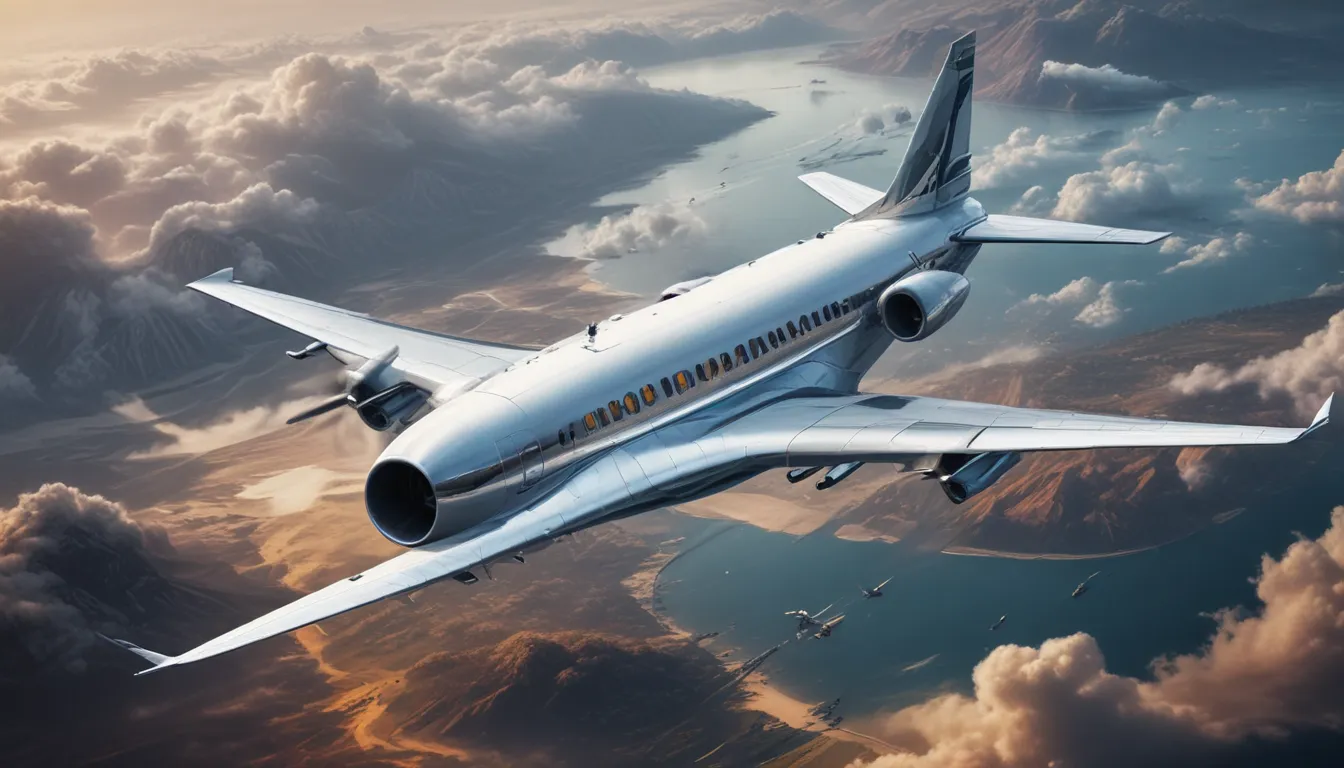A Note About Images: The images used in our articles are for illustration purposes only and may not exactly match the content. They are meant to engage readers, but the text should be relied upon for accurate information.
Airplanes have transformed the way we travel, connect with the world, and explore new horizons. These engineering marvels have a rich history that continues to captivate people globally. In this article, we will delve into 21 fascinating facts about airplanes that highlight their incredible capabilities, technological advancements, and impact on global transportation. Whether you are an aviation enthusiast, a frequent traveler, or simply curious about the world of aviation, these facts will provide a captivating glimpse into the fascinating realm of airplanes.
Exploring the Evolution of Aviation
From the early pioneers of flight to the cutting-edge aircraft of today, the evolution of airplanes has been nothing short of extraordinary. Let’s uncover the impressive statistics, remarkable achievements, and lesser-known aspects of these flying machines that have shaped the world we live in.
The Wright Brothers: Pioneers of Flight
In 1903, Orville and Wilbur Wright achieved the first powered, sustained, and controlled airplane flight, marking a monumental milestone in modern aviation. Their Flyer flew for 12 seconds over 120 feet at Kitty Hawk, North Carolina, laying the foundation for the future of air travel.
Airbus A380: The World’s Largest Passenger Airplane
Boasting a wingspan of 262 feet and the capacity to carry over 500 passengers, the Airbus A380 stands as a marvel of engineering. Its advanced features redefine the possibilities of air travel, offering a glimpse into the future of aviation technology.
Boeing 747: The Iconic “Queen of the Skies”
Since its debut in 1968, the Boeing 747 has been synonymous with long-haul flights, captivating travelers worldwide with its distinctive hump and remarkable performance. This iconic aircraft continues to be a symbol of aviation excellence.
Concorde: A Leap in Supersonic Technology
The Concorde, the first supersonic passenger-carrying commercial airplane, revolutionized air travel with its ability to travel at twice the speed of sound. It represented a significant leap forward in aviation technology and luxury travel, showcasing the possibilities of supersonic flight.
Boeing 787 Dreamliner: A Sustainable Innovation
The Boeing 787 Dreamliner incorporates advanced composite materials, making it lighter and more fuel-efficient than its predecessors. With its innovative design and state-of-the-art features, this aircraft sets new standards for sustainability and passenger comfort in the aviation industry.
Captivating Tales of Aviation Excellence
Let’s now explore some remarkable stories and achievements that highlight the profound impact of airplanes on our lives and the world.
The Blackbird SR-71: Setting Speed Records
The Blackbird SR-71 holds the record for the fastest air-breathing manned aircraft, reaching speeds exceeding Mach 3. This extraordinary reconnaissance aircraft showcases unparalleled engineering prowess and pushes the boundaries of aeronautical achievement.
“Miracle on the Hudson”: Captain Sullenberger’s Heroic Landing
In 2009, Captain Chesley “Sully” Sullenberger executed an emergency water landing of US Airways Flight 1549 on the Hudson River, saving all 155 passengers and crew on board. His quick thinking and expertise averted a potential disaster, highlighting the skill and professionalism of pilots in critical situations.
Humanitarian Aid Efforts: A Lifeline in Times of Crisis
Airplanes play a pivotal role in humanitarian aid and disaster relief efforts, facilitating the rapid transportation of essential supplies, medical personnel, and relief workers to affected regions. During natural disasters and humanitarian crises, these flying machines become vital lifelines for those in need.
Technological Advancements in Aviation
Discover the innovative technologies that have revolutionized aircraft design and operations, shaping the way we travel and experience air transportation.
Fly-By-Wire Technology: Enhancing Aircraft Control Systems
Fly-by-wire systems have revolutionized aircraft control by utilizing electronic signals for flight control, enhancing maneuverability and safety in aviation operations. This innovation has ushered in a new era of precision and responsiveness in aircraft design, improving the overall flying experience.
Glass Cockpit Displays: Improving Pilot Situational Awareness
Modern airplanes feature advanced electronic flight instrument displays known as glass cockpits. These digital displays replace traditional analog gauges, providing pilots with comprehensive flight information and enhancing situational awareness for safer and more efficient operations.
Area Rule Concept: Revolutionizing Aircraft Design
The “area rule,” pioneered by engineer Richard Whitcomb, revolutionized aircraft design by reducing drag and improving performance. This aerodynamic principle, which shaped the distinctive “Coke bottle” fuselages of certain aircraft, has significantly enhanced aircraft efficiency and overall aerodynamics.
Unveiling Aviation Insights and Fun Facts
Delve into intriguing tidbits and lesser-known facts that shed light on the fascinating world of airplanes, inspiring a deeper appreciation for the wonders of aviation.
The “Pilot’s Handshake”: A Symbol of Trust and Camaraderie
Before every flight, the captain and first officer traditionally share a firm handshake, symbolizing trust, teamwork, and a shared commitment to safety. This symbolic gesture reflects the professional camaraderie essential to successful aviation operations and the importance of effective communication in the cockpit.
The “Angle of Attack”: Maintaining Optimal Flight Conditions
The angle of attack refers to the angle between an aircraft’s wing and the oncoming air, crucial for maintaining optimal lift and controlling flight characteristics. Understanding and managing the angle of attack is essential for safe and efficient flight operations, highlighting its significance in aviation.
The “Boneyard”: A Hub of Aircraft Storage and Maintenance
The “boneyard” serves as a storage and maintenance facility for retired airplanes, such as the Davis-Monthan Air Force Base in Arizona. These vast facilities house retired aircraft awaiting potential reactivation, dismantling, or recycling, reflecting the lifecycle of aviation assets and the history of aircraft preservation.
Conclusion: Embracing the Legacy of Aviation
In wrapping up our journey through the fascinating world of airplanes, we celebrate the remarkable evolution and enduring impact of aviation on the modern world. From pioneering achievements to technological innovations, airplanes continue to shape global connectivity, transportation, and exploration, embodying the spirit of human ingenuity and progress.
As we look to the future, the ongoing advancements in aircraft design and propulsion promise to redefine our relationship with the skies and open up new horizons for exploration and discovery. With a blend of innovation, engineering prowess, and a touch of magic, airplanes remain a symbol of human ingenuity and the boundless possibilities that await us in the endless expanse above.
FAQs: Exploring Further Aviation Insights
Q: What is the history behind the invention of airplanes?
A: The concept of flight has fascinated humans for centuries, with the Wright brothers achieving the first powered, sustained, and controlled airplane flight in 1903, marking a pivotal moment in aviation history.
Q: How do airplanes stay in the air?
A: Airplanes remain aloft through the principles of aerodynamics, with wings designed to create lift that counteracts gravity, allowing the aircraft to maintain flight.
Expand your aviation knowledge by exploring more captivating topics related to airplanes and air travel. From paper airplane contests to the altitudes planes reach, there’s a world of fascinating insights waiting to be discovered. Dive into the exciting realm of aviation and continue your exploration of the wonders of flight.
Thank you for joining us in celebrating the awe-inspiring world of airplanes and the enduring legacy of aviation excellence. Together, let’s soar to new heights and embrace the limitless possibilities that aviation offers. Safe travels and happy exploring!






